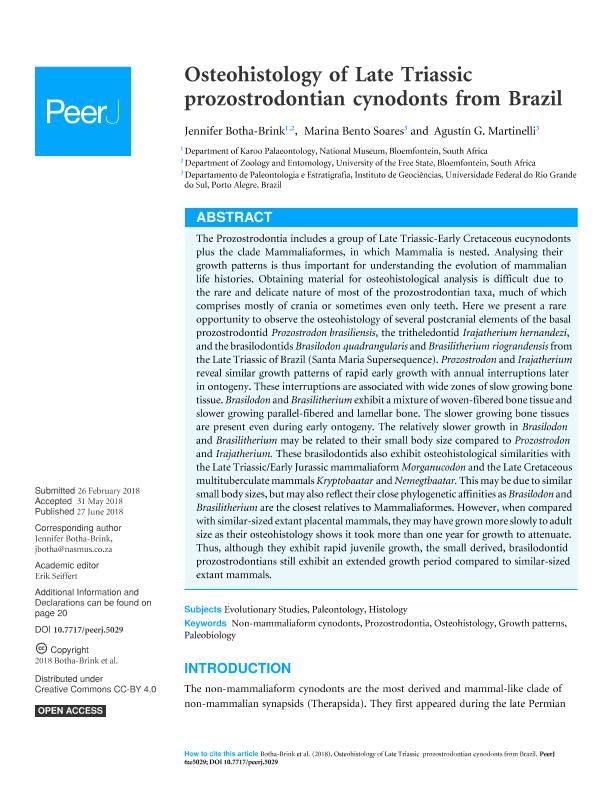Mostrar el registro sencillo del ítem
dc.contributor.author
Botha-Brink, Jennifer
dc.contributor.author
Soares, Marina Bento
dc.contributor.author
Martinelli, Agustín Guillermo

dc.date.available
2020-01-08T21:46:11Z
dc.date.issued
2018-07
dc.identifier.citation
Botha-Brink, Jennifer; Soares, Marina Bento; Martinelli, Agustín Guillermo; Osteohistology of Late Triassic prozostrodontian cynodonts from Brazil; PeerJ; PeerJ; 2018; 6; 7-2018; 1-26
dc.identifier.issn
2167-8359
dc.identifier.uri
http://hdl.handle.net/11336/94075
dc.description.abstract
The Prozostrodontia includes a group of Late Triassic-Early Cretaceous eucynodonts plus the clade Mammaliaformes, in which Mammalia is nested. Analysing their growth patterns is thus important for understanding the evolution of mammalian life histories. Obtaining material for osteohistological analysis is difficult due to the rare and delicate nature of most of the prozostrodontian taxa, much of which comprises mostly of crania or sometimes even only teeth. Here we present a rare opportunity to observe the osteohistology of several postcranial elements of the basal prozostrodontid Prozostrodon brasiliensis, the tritheledontid Irajatherium hernandezi, and the brasilodontids Brasilodon quadrangularis and Brasilitherium riograndensis from the Late Triassic of Brazil (Santa Maria Supersequence). Prozostrodon and Irajatherium reveal similar growth patterns of rapid early growth with annual interruptions later in ontogeny. These interruptions are associated with wide zones of slow growing bone tissue. Brasilodon and Brasilitherium exhibit a mixture of woven-fibered bone tissue and slower growing parallel-fibered and lamellar bone. The slower growing bone tissues are present even during early ontogeny. The relatively slower growth in Brasilodon and Brasilitherium may be related to their small body size compared to Prozostrodon and Irajatherium. These brasilodontids also exhibit osteohistological similarities with the Late Triassic/Early Jurassic mammaliaform Morganucodon and the Late Cretaceous multituberculate mammals Kryptobaatar and Nemegtbaatar. This may be due to similar small body sizes, but may also reflect their close phylogenetic affinities as Brasilodon and Brasilitherium are the closest relatives to Mammaliaformes. However, when compared with similar-sized extant placental mammals, they may have grown more slowly to adult size as their osteohistology shows it took more than one year for growth to attenuate. Thus, although they exhibit rapid juvenile growth, the small derived, brasilodontid prozostrodontians still exhibit an extended growth period compared to similar-sized extant mammals.
dc.format
application/pdf
dc.language.iso
eng
dc.publisher
PeerJ
dc.rights
info:eu-repo/semantics/openAccess
dc.rights.uri
https://creativecommons.org/licenses/by/2.5/ar/
dc.subject
GROWTH PATTERNS
dc.subject
NON-MAMMALIAFORM CYNODONTS
dc.subject
OSTEOHISTOLOGY
dc.subject
PALEOBIOLOGY
dc.subject
PROZOSTRODONTIA
dc.subject.classification
Paleontología

dc.subject.classification
Ciencias de la Tierra y relacionadas con el Medio Ambiente

dc.subject.classification
CIENCIAS NATURALES Y EXACTAS

dc.title
Osteohistology of Late Triassic prozostrodontian cynodonts from Brazil
dc.type
info:eu-repo/semantics/article
dc.type
info:ar-repo/semantics/artículo
dc.type
info:eu-repo/semantics/publishedVersion
dc.date.updated
2019-10-16T19:29:31Z
dc.journal.volume
2018
dc.journal.number
6
dc.journal.pagination
1-26
dc.journal.pais
Estados Unidos

dc.description.fil
Fil: Botha-Brink, Jennifer. National Museum; Sudáfrica. University Of The Free State; Sudáfrica
dc.description.fil
Fil: Soares, Marina Bento. Universidade Federal do Rio Grande do Sul; Brasil
dc.description.fil
Fil: Martinelli, Agustín Guillermo. Universidade Federal do Rio Grande do Sul; Brasil. Consejo Nacional de Investigaciones Científicas y Técnicas; Argentina
dc.journal.title
PeerJ
dc.relation.alternativeid
info:eu-repo/semantics/altIdentifier/doi/http://dx.doi.org/10.7717/peerj.5029
dc.relation.alternativeid
info:eu-repo/semantics/altIdentifier/url/https://peerj.com/articles/5029/
Archivos asociados
